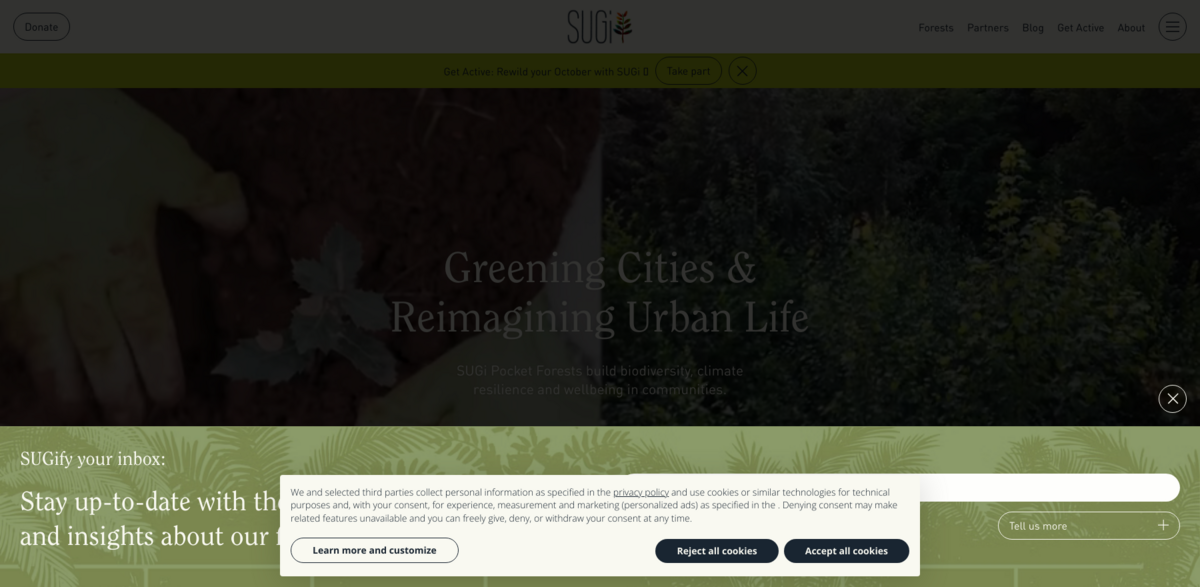What Are SUGi Pocket Forests?
Imagine tiny forests popping up in the heart of cities… That’s exactly what SUGi Pocket Forests are all about. These ultra-dense, biodiverse patches of native species transform urban spaces into vibrant ecosystems. They’re not just about planting trees; they’re about reimagining urban life, greening cities, and creating sanctuaries where nature and community thrive side by side.
The Main Benefit: Climate Resilience and More
SUGi Pocket Forests offer a natural, effective, and easy-to-implement solution to some of the biggest environmental challenges cities face today. Here’s what they bring to the table:
- Climate Resilience: These forests help cities adapt to climate change by improving air quality, reducing heat, and managing water runoff.
- Community Strengthening: Restoring soil and green spaces fosters social bonds and helps people reconnect with nature.
- Biodiversity Boost: Only native species are planted, creating rich habitats for local wildlife.
Featured Forests Around the World
From London to São Paulo, and Karachi to Cape Town, SUGi Pocket Forests are making waves globally. Each forest tells a unique story:
- Heritage Forest in Kensington and Chelsea, London — a green sanctuary in the city’s heart.
- Danehy Park Forest in Cambridge, MA — turning a former landfill into a thriving forest.
- Southbank Centre — Natura Nostra Forest in London — nature thriving amid brutalist architecture.
- Trapa Trapa Forest in Santiago, Chile — a peaceful refuge for patients and caregivers.
- Capão Redondo Forest in São Paulo — restoring Atlantic forest for 3,000 students.
- Clifton Urban Forest in Karachi — a green lung in the city center.
- Beirut’s Riverless Forest — reclaiming public space and biodiversity.
- Car Park Forest in Mechelen, Belgium — transforming concrete into life.
- Khoi First Nations Forest in Cape Town — preserving Khoi tribe traditions.
- Healing Forest in Yakama Nation, WA — restoring harmony between body, mind, and spirit.
- Ambedkar Legacy Forest in Aurangabad, India — standing for justice.
- Manhattan Healing Forest on Roosevelt Island, NYC — planting for resilience.
- MLK Middle School Outdoor Classrooms in Berkeley, CA — green spaces for East Bay students.
- Forest of Thanks in Barking and Dagenham, London — a symbol of resilience and hope.
- Pirque Forest in Chile — from parking lot to parks.
- Bulu Rewilding in Buea, Cameroon — protecting water catchments.
- Gurrbum in Queensland, Australia — reconnecting corridors for the endangered southern cassowary.
- Ancestral Forest in Pattaya, Thailand — blending art and nature in a sensory forest.
Meet the Forest Partners
Partnerships are at the heart of SUGi’s mission. Collaborators who share the vision of building biodiversity and green infrastructure come together to tailor each project uniquely. These strategic alliances ensure that every forest is more than just trees — they’re community-driven, culturally meaningful, and ecologically impactful.
Forest News and Stories
There’s always something growing in the world of SUGi Pocket Forests. Recent highlights include:
- Connection Takes Generations to Grow — a reminder that nurturing nature is a long-term commitment.
- Growing Proof: Testing the Miyawaki Method for urban tree success in the UK.
- Nature Doesn’t Do Straight Lines — embracing the wild, organic beauty of natural growth.
- A Forest First for Mexico City — breaking new ground in urban forestry.
- SUGi Walks — community events that bring people closer to their local forests.
Impact on Sustainable Development Goals (SDGs)
- SDG 11: Sustainable Cities and Communities — making urban areas greener and healthier.
- SDG 13: Climate Action — enhancing resilience to climate change.
- SDG 15: Life on Land — restoring biodiversity and ecosystems.
- SDG 3: Good Health and Well-being — promoting mental and physical health through nature.
- SDG 17: Partnerships for the Goals — fostering collaboration for sustainable impact.
Why Urban Pocket Forests Matter
In a world where concrete often dominates, SUGi Pocket Forests remind us that nature can reclaim its space — even in the busiest cities. These forests aren’t just green spots; they’re hubs of life, learning, and healing. They reconnect people with the earth beneath their feet and inspire hope for a greener, more resilient future. So next time you see a tiny forest tucked away in an urban corner, know it’s part of a bigger story — one of biodiversity, community, and climate resilience growing strong.





















